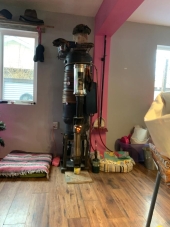


























 1
1























































![Filename: rmh-diagram.png
Description: [Thumbnail for rmh-diagram.png]](/t/19178/a/44939/rmh-diagram.png)

 1
1





 1
1


































Joanna Sheldon wrote:Hello everyone. I'm new to permies, and glad to be here. Ex-NYer, living in the UK... I have a 12' x 8' greenhouse in zone 9, and would like to put a 6" core system in one end of it, run pipe under the soil down the length of the north long bed, across to the south bed, back up that bed and out. One of the main uses for this heater will be to rescue my poor tomatoes, peppers, eggplants, and melons in July when we often get a couple of weeks of rain and chill weather, just as everything's struggling to ripen... I've attached a picture of the greenhouse.




Jean-Yves Lepercq wrote:
..The greenhouse is ongoing. It's gonna be 41*28 ft hence around 1150 sqft. The northern side will be a insulated concrete wall. South side will be 5 large double glass windows. Roof and small sides will be made of 32mm polycarbonate. Structure will be made of wood...
..Problem is I need to heat up the baby every night during october to march/april. Winter temperatures here are around freezing point and days are very short. At night, without heating, inside temperature will probably go as far down as outside temperature. Which is totally incompatible with my orchids and all the delicious veggies of my wife...
..- I want a batch box because due to our activity we won't have 2 hours to spend each day to maintain a J tube RMH...
JY








Gilbert Fritz wrote:I'm new to this thread.
I want to build a bunch of hot frames on my back patio, and heat them with a rocket heater.
 3
3












I lived in Denver for 10 years and I consider the rocket mass heater to be a waste of time and energy for this application. Before planning and building gardens in this environment you might find it important to study a manual on xeriscaping just to become familiar with the realities of sudden humidity drops down to around 10%.
Even though it doesn't resemble Scottsdale, Santa Fe or Phoenix, all the same "semi-arid" (read desert) rules apply right up until you begin to get those regular Spring and seasonal Summer rains. As to building a RMH in your yard and extending the use of your living space accordingly, I strongly agree with the principal lifestyle benefits this could bring.
Google: "Dome Greenhouse, Colorado" and you'll gain insight on 'how to' abate the harsh mountain climate, the expensive way. Picture your same Denver lot in Summit County, and one might certainly begin to brood the combination of the RMH add-on for these gorgeous kit-built geodesic contraptions.
"Hot boxes" function first, in proportion to their depth. A 1ft deep box becomes scalding hot in all but the coldest months, while a sloping box that's around 16" deep at the front and a 24-26" at the rear should generate plenty of heat to start just about anything at elevations around 5,000 ft. The ability to remove the entire assembly would enable you to get a big head start on not just portable flats, but perennials and bedding plants such as tomatoes and peppers. A small pair or series of matching boxes with 1/4" tempered glass spanning no more than 2' x 4' is the most acceptable way to go. Snow is heavy, and insulating. You simply brush it off as the sun begins to reappear.
Hoop gardens and high tunnels follow the same rules. Start by building something with 3/4" PVC at just over just 3 feet tall, and use standard (not real transparent, but thick) PVC 'visqueen' and you will quickly see what I mean about heat and depth being principally in play. Your beds of lettuce and spinach would be thriving by now.




“The most important decision we make is whether we believe we live in a friendly or hostile universe.”― Albert Einstein
 1
1




www.MicroEcoFarming.com
www.RegenerativeAgrarian.com
 1
1




To land on this Kind Pharm has been a blessing and a curse! May your days be yin/yanged and exciting! May those that meet us leave us with a song and smile! Carpe Diem!
 1
1




I make a Maple Syrup instructional movie! Check it out HERE
SKIP books, get 'em while they're hot!!! Skills to Inherit Property
See me in a movie building a massive wood staircase:Low Tech Lab Movie

 2
2




For all your Montana Masonry Heater parts (also known as) Rocket Mass heater parts.
Visit me at
dragontechrmh.com Once you go brick you will never go back!

|
I'm sure glad that he's gone. Now I can read this tiny ad in peace!
The new purple deck of permaculture playing cards
https://www.kickstarter.com/projects/paulwheaton/garden-cards
|



